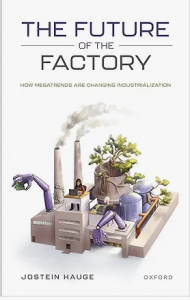Joshua Freeman’s Behemoth: A History of the Factory and the Making of the Modern World starts – of course- with the cotton mills of northern England during the Industrial Revolution. The early chapters had a (reverse-)Proustian effect, reminding me of the distinctive assault on the senses of taking my dad his lunch in his spinning mill, where he was a mule operator, or going to see my aunties in their weaving shed: the rhythmic clatter of the machines, the smell of hot grease and cotton dust. But they were small factories. The book’s theme is the economic and cultural role of giant factoriesm behemoths.
It’s an engrossing read, progressing from Manchester in England – inspiration for Marx and Engels (the latter running a mill there) – to the New England textile industry and the American System; the late 19th century enthusiasm for factories and manufactures with the Crystal Palace Exhibition and other grand fairs; Ford and Fordism; Soviet Gigantism; the Cold War era of mass production; and ending with the giant plants in China and elsewhere in Asia today.
The book notes the magnetic appeal of big factories, even for their social critics. This started early. In the 19th century, campaigners’ indignation focused on conditions of work in the new factories, including their use of child labour. Quite right too. Yet, Freeman notes, “The novelty of the factory system drew attention to the exploitation of its workforce, while the long-standing exploitation of agricultural workers, domestic producers, servants (encompassing twice as many women as in the textile industry) and others went largely unnoted by politicians, journalists and writers, who had little interest in the lower classes.” (The same is true now of the commentariat’s focus on ‘gig’ work via digital platforms; there are lots of worse jobs around.)
For much of their history, factories have been seen as symbols of modernity – including in the arts, especially by photographers such as Margaret Bourke-White or Alexander Rodchenko. In the late 19th century again, the structures of industry represented the Sublime. The link of the huge factory complex with modernity was particularly striking in the newly industrialising Soviet Union – and one of the things I learned from the book was how much that had depended on American engineers, designers, foremen, trainers in the 1920s and 1930s. The Soviet sphere continued to manufacture on a giant scale until 1989. As a journalist in 1990, I visited the Ganz Elecrtic plant near Budapest, up for sale to western investors. Steel went in at one end, everything from buses and lightbulbs emerged at the other. Some giant plants even had steel mills, integrating the entire vertical chain.
Yet in the US the biggest companies moved away from their emphasis on huge plants like Ford’s River Rouge – a tourist destination and much photographed and celebrated – in part to reduce their vulnerability to organised labour and industrial action. The need for labour and the constant to and fro in power relations is one of the threads running through the book. Freeman argues that unionization and labour power get too little attention in the economic literature on industrial location, which I think is right. The communist countries were able to continue on the behemothic scale because unions were part of the social state.
The book ends with China’s giants, such as Foxconn City. Why are they still so big, Freeman asks? These are not long and complex production lines like those involved in building a modern car or an aircraft. And there are diseconomies of scale in terms of management and organisation – not to mention hiring and managing such a large workforce – which one might have expected to lead to production on a smaller scale. His answer is that scale today serves the retailers, not the manufacturers. The focus on marketing and branding by the likes of Apple or Nike means they want consistent, timely and huge runs of new products. Modern communications – virtual and physical – have made contract manufacturing possible on this immense scale. Many western manufacturers outsourced their manufacturing from the mid-1990s. So whereas 19th and 20th century giant factories were public marvels – criticised, yes, but also admired, visited, debated – 21st century factories in China are dull boxes surrounded by walls and rarely photographed.
Still less do they inspire poets like Walt Whitman, who wrote of the sublimeness of steam power. The poetry quoted here is by a young Foxconn worker who committed suicide: “They’ve trained me to become docile/Don’t know how to shout or rebel/How to complain or denounce/Only how to silently suffer exhaustion.”
Being a factory worker has always been exhausting, draining, deafening, dangerous – for all that there are worse alternatives. Although unions briefly won great gains for (male, long-term) factory workers in the mid-20th century, leading some people now to romanticise blue collar jobs and factory communities, I’m happy to see robots taking over ever-more of the work. And yet, and yet, factories are still fascinating.
[amazon_link asins=’0393246310′ template=’ProductAd’ store=’enlighteconom-21′ marketplace=’UK’ link_id=’37925f4c-35cc-11e8-8284-4fd87c27cf54′]


